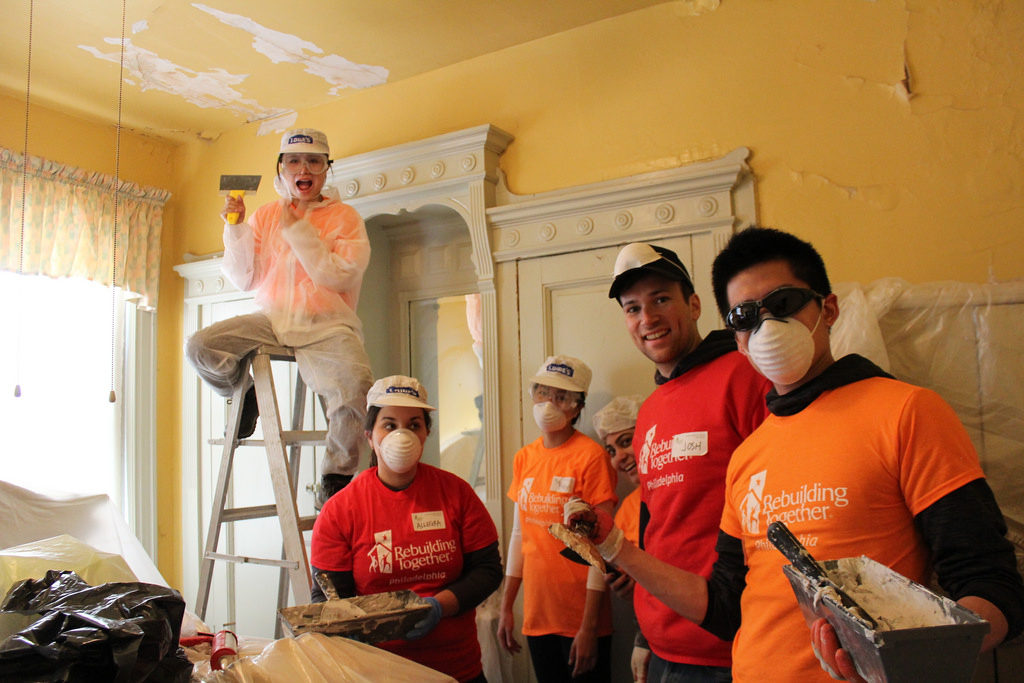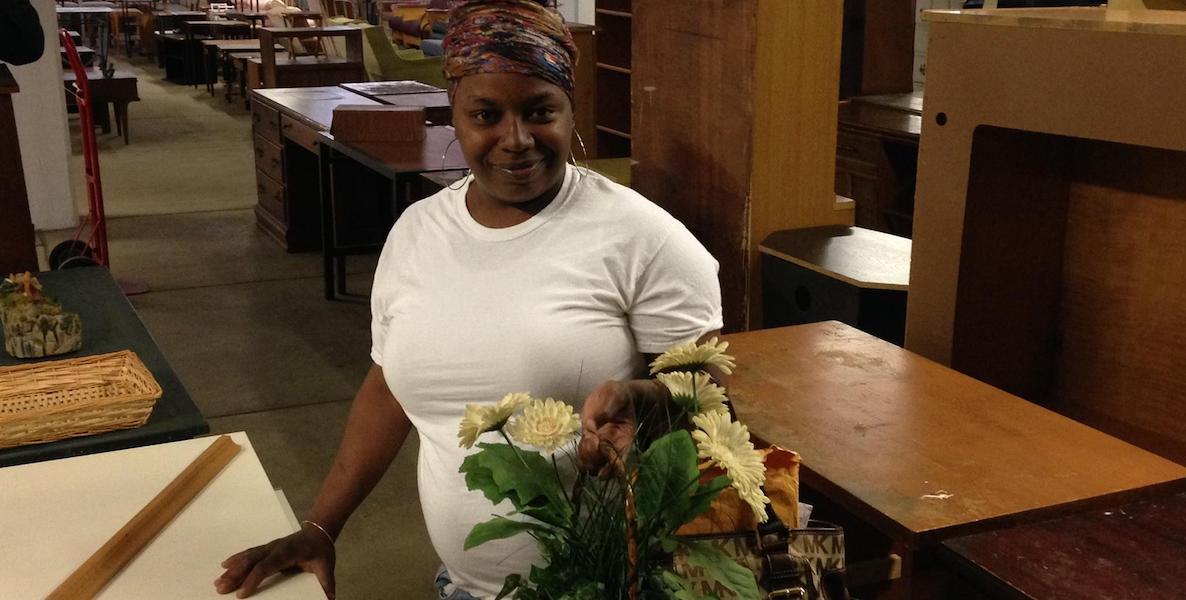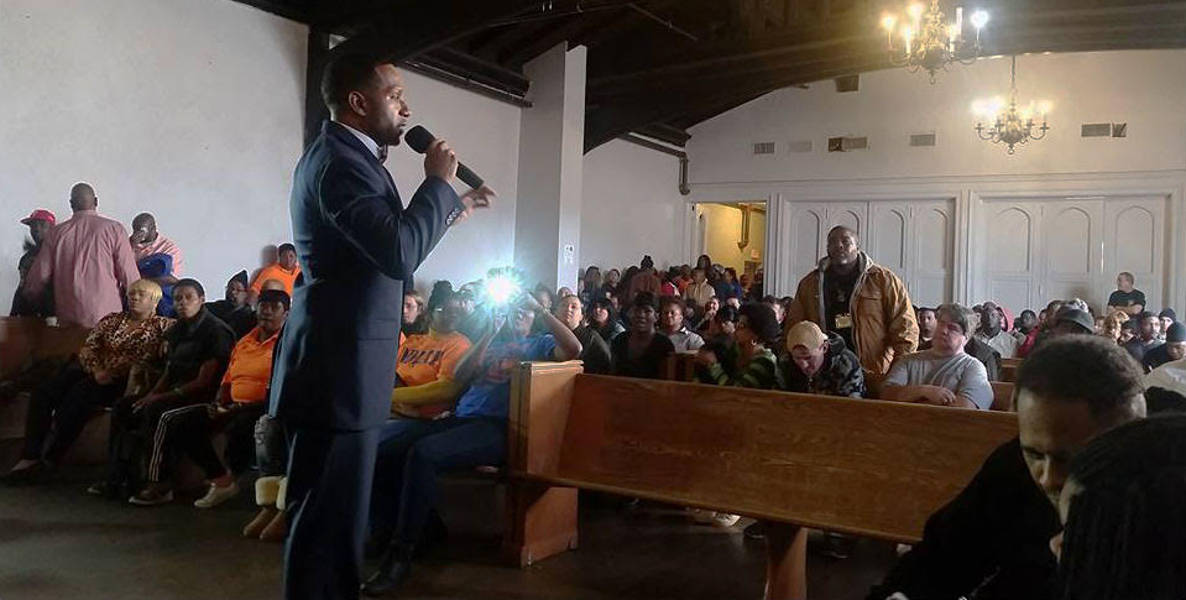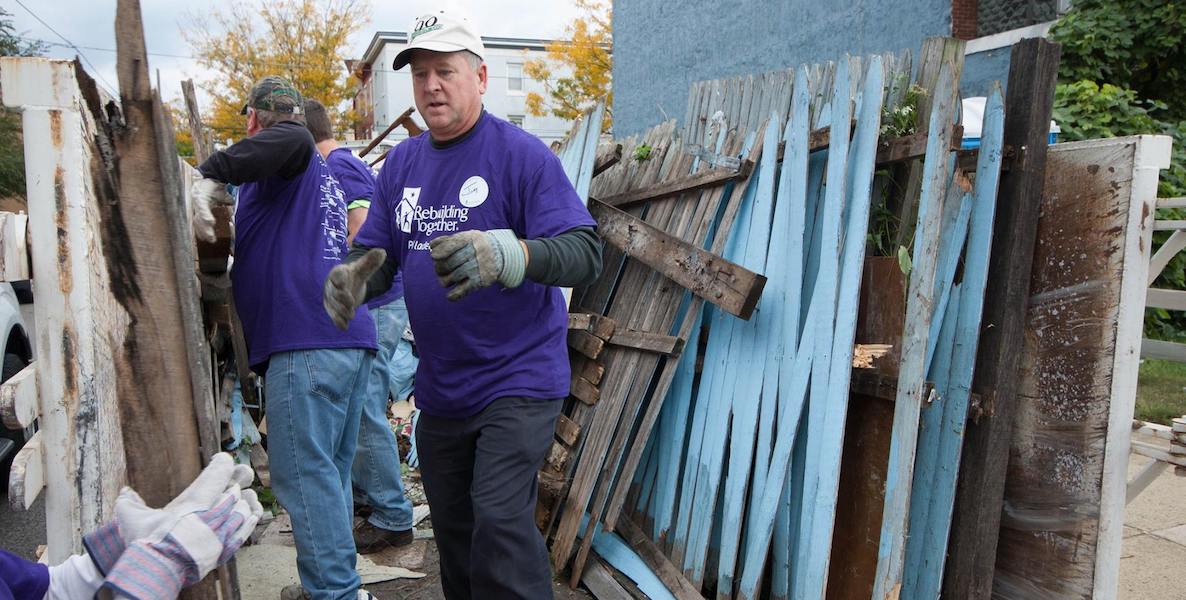The weather is horrible. Just atrocious. It’s hovering just above the freezing point and West Philadelphia is enshrouded by a storm of monsoon strength; the raindrops that hit windshields splatter to the size of silver-dollar pancakes. It is, in short, the shittiest day of this young year, not fit for man or beast, the whole nine yards of abject, grey misery.
And yet, on Ogden Street, they’re working like it’s a gorgeous day at the end of May, milling about and shuttling in and out of homes; the air is filled with the muffled sounds of construction work.
Rebuilding Together Philadelphia has descended on the block, and they are in the opening throes of doing their thing. The group, over the course of the weekend, is going to make massive repairs to 15 houses in the neighborhood, and they’re moving fast; by noon on day one, the crews have largely cleared out several homes, and workers are beginning to take measurements for new flooring and fixtures. And no one seems particularly put off by the rain; there’s work here to get did, and it’s got to get did, rain or shine.

Before I arrive, Mayor Kenney had swung by to say a few words about the value of Rebuilding Together Philadelphia’s mission before retreating into his climate-controlled automobile. Was he good to go? Did he caulk some cracks or carry the hod? “Oh no, no,” says Stefanie Seldin, executive director of Rebuilding Together Philadelphia. “No, he was wearing a suit.”
Seldin is babysitting the whole operation, checking in on everybody as they go through the motions of putting this block back together. “Rebuilding Together Philadelphia revitalizes communities by transforming vulnerable, owner-occupied houses into safe, healthy and energy efficient homes,” she says, without missing a beat. “I’ve got the shpiel down good; three and a half years I’ve been working at it.”
Seldin seems to have things well in hand. She has not only the lawyerly ability to run through an entire mission statement without missing a beat, but the uncanny talent of keeping things together on a hectic worksite; she’s tapping shoulders and directing helpers all day. This is not Seldin’s first go at helping to keep people in their homes. Prior to joining RTP, she was the managing attorney at Philadelphia VIP, a non-profit that helps underprivileged Philadelphia homeowners attain legal help in housing disputes. But when she’s working with RTP outside, she’s as much a construction forewoman as a non-profit chief.
“Cover this flooring up; it’s just sitting out here in the rain, and I don’t want it to get destroyed,” she directs a volunteer as we make our way around the neighborhood. It’s those volunteers that drive RTP, Seldin says. Sure, there are a few construction crews that they work with regularly, but most of their workers, on a day like today, are volunteers from area businesses and colleges. Today, some Penn design students are working on the 16 houses in west Philly, and Sunday a bunch of Drexel students will be helping out. A substantial portion of their volunteers, she says, also come from RTP’s corporate sponsors, including consulting giant Booz Allen Hamilton and Wells Fargo; still more are unattached volunteers.
When the program was in its infancy, the exclusively college-kid volunteers worked on fewer than a dozen houses per year; today, they have worked with nearly 35,000 volunteers of all stripes, and worked on nearly 1,500 Philadelphia homes.
If workers from groups like Wells and Booz seem a little out of place doing major and regular restorative work, well, that’s part of the founding ethos of RTP. The group was put together nearly 30 years ago by a group of Wharton grad students, who were trying to change the perceptions—and the reality—of what business-types can offer an urban community. Back then, it was known as Christmas in April; about 10 volunteer students would work on one home at a time. But the outfit expanded exponentially, and renamed itself Rebuilding Together Philadelphia in 2004 following its conversion to a fully-fledged non-profit a few years earlier.
Today, that philosophy that drove those Wharton students still propels RTP, an example of a pertinent social consciousness among the sort of capitalism that often can be a bane, both real and perceived, to underserved communities. In addition to the Lenfest Foundation and the Philadelphia Housing Development Corporation, the organization is funded by FHL Bank in Pittsburgh, and by Wells Fargo—which contributes money and manpower to the work of keeping people in their homes.
That work is no small thing. Research has shown that one of the primary reasons why people are forced to leave their homes—more than higher taxes, or gentrification—is the cost of repairs. Fixing a roof, or clogging leaks or sealing off drafts can sometimes cost more than low-income residents can manage, even if they own their homes outright. These issues can cause or exacerbate chronic health problems, like asthma. And houses that are falling apart, and then abandoned, have an effect on the whole neighborhood: An abandoned house decreases the property value of other houses on the street by $8,000.
Seldin says that there will be 200 workers and volunteers on site today, and that over the course of the weekend they expect more than 600 to put in some time on Ogden Street. Much of the heavy skilled work is done by construction crews who have donated their services. Volunteers help with all kinds of interior work, from measuring and laying flooring to moving furniture. On an RTP site, everyone’s got a job, and for good reason: They’ve typically only got a weekend to make major fixes to up to 20 homes.
If workers from groups like Wells and Booz seem a little out of place doing major and regular restorative work, well, that’s part of the founding ethos of RTP. The group was put together nearly 30 years ago by a group of Wharton grad students, who were trying to change the perceptions—and the reality—of what business-types can offer an urban community.
Bill Wilken, according to Seldin, is kind of part of the decor at RTP. He can’t quite say how many times he’s volunteered; he says that he counts experience with the group not in hours or days, but in houses fixed — which is more than 20. He’s a volunteer who has a lot of time on his hands since his kids left for college, and loves the hands-on, tangible aspect of working with RTP. Seldin says he’s a little obsessive, always needing “one more hour” to get his work done. And Wilken’s got some skills, too; far from a standard volunteer, he’s taking measurements so he can cut some flooring for a kitchen when I talk to him. But he says the work, more than anything, is incredibly gratifying.
“Sometimes people don’t know how to thank you, or they don’t have much to thank you with,” he says. “Sometimes they’ll write you a note, but they do what they can. One time, a woman was thankful enough to make us fried chicken. That was the best.”
Wilken says that the RTP does what amounts to a full structural makeover of the home, everything from energy saving modifications to safety to projects affecting safety and health. To find neighborhoods, they work with community partners, like the People’s Emergency Center and Mount Vernon Manor, which identify blocks with houses that are most direly in need of repair.
“PEC actually helped us find this wonderful block,” says Seldin of the Ogden Street neighborhood. When the program was in its infancy, the exclusively college-kid volunteers worked on fewer than a dozen houses per year; today, they have worked with nearly 35,000 volunteers of all stripes, and worked on nearly 1,500 Philadelphia homes.
And RTP’s folks work with a purpose; they blast through their work break at around noon, and within 30 minutes, the porches where they took their lunch are completely empty. Everyone has retreated indoors to do what they came here to do: rebuild Philadelphia.
Photo courtesy Rebuilding Together Philly on Flickr






